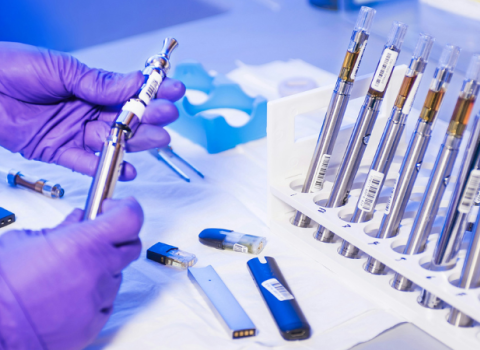As governments around the world scramble to start up green hydrogen economies, scientists are pointing to an underexplored source of the gas – natural hydrogen continuously generated in the earth’s crust

Hydrogen could be taken straight from the ground to supplement hydrogen derived from fossil fuels and renewables, according to scientists researching this underexplored alternative.
Natural, or white, hydrogen is continuously produced in the earth’s crust, and scientists are now discovering there’s much more of it stored underground than previously thought.
It’s a renewable resource that can be captured by simply drilling a well. One such pool was found in Mali in the 1980s, but it took decades before someone proposed to extract the gas. Today, the well gives out 98% pure hydrogen and has not recorded any decrease in production since extraction started in 2012.
“The real challenge now is to find places in the world where the flux is high enough and the concentration is high enough,” said Nick Arndt, emeritus professor of geochemistry at the Grenoble Alpes University. “So currently, [scientists] are looking in places in the world where we know that there is a flux of hydrogen.”
Industry is ready to hop on the natural hydrogen train too. The French energy company Engie has been exploring the potential of natural hydrogen since 2016. It started off with projects in Brazil, where the company developed sensors to monitor the flux of hydrogen in specific areas, and has since expanded to other areas in the world.
Now, competition is picking up as start-ups and bigger companies turn to natural hydrogen, rushing to get licenses to explore its potential. “There is a lot of competition. We saw that in the South Australia state when they opened the mining rights to natural hydrogen exploration,” said Olivier Lhote, special adviser on hydrogen at Engie.
White vs grey vs green
Hydrogen is touted as a key source of energy that will help decarbonise economies around the world. The EU launched its hydrogen strategy in 2020, calling for €470 billion in investment by 2050 and setting out the goal to produce up to 10 million tonnes of the renewable version of the gas each year by 2030.
Today most hydrogen is produced by reforming natural gas but a green version of hydrogen can be made through the process of electrolysis where a current of renewable energy goes through water to separate hydrogen and oxygen.
This so-called green hydrogen is expected to be the fuel of the future, used to decarbonise heavy duty industry, steel-making and long-haul freight. But today green hydrogen remains expensive and there’s not enough renewable energy to meet the demand. This is where natural hydrogen could fill the gap.
Viacheslav Zgonnik, a researcher who has been exploring the potential of white hydrogen for the last decade and managing a start-up in the field since 2013, says that preliminary estimates show natural hydrogen may be the cheapest alternative of the gas at $0.1 to $1 per kilogramme, even cheaper than currently dominant grey hydrogen.
However, until more projects are up and running, these are only estimates. More investment and demonstration projects are needed to prove the concept and convince government and larger companies to take natural hydrogen seriously.
Two years ago, Zgonnik’s company Natural Hydrogen Energy was the first in the US to drill specifically for natural hydrogen and is now preparing to drill new wells this year. “What is necessary is more demonstrational projects to convince people that it works, that it could be massively deployed,” said Zgonnik. “We hope to be the first in America to start this extraction and production.”
Across the Atlantic, Engie is eyeing up concrete projects to be up and running in two to three years’ time. Lhote says once the company acquires a license to explore, getting a project to an operational stage will take a few years of collecting data and de-risking the venture.
Green enough
It’s unclear whether natural hydrogen would be classified as low-carbon in the EU’s system as white hydrogen is not on the European Commission’s radar just yet but proponents say environmental risks are minimal.
Arndt says almost any way of producing energy will carry environmental costs. With natural hydrogen, the drilling of the well will produce noise, dust and in rare cases could end up contaminating the water table. But these are local and temporary impacts, he noted, and lesser than those associated with most other energy sources.
“Our conviction is that that extraction of natural hydrogen could be done with minimal impact on the environment to provide what is really a renewable resource, a carbon-free resource,” said Arndt.
One advantage of natural hydrogen is that it takes out the most energy-consuming and CO2-emitting part of the process out of the equation. To make grey hydrogen, a company must drill the well for natural gas, purify, transmit, steam and reform it before it turns into hydrogen. With natural hydrogen, the process ends with purification, making it a low-carbon endeavour.
To extract the gas, operators will simply drill wells and purify the product, a relatively simple process. Engie says fracking will not be on the table. “That’s not the idea. We want to benefit from natural gas. If vertical wells do not work, we could start with horizontal ones,” said Lhote.
The idea is to extract the low carbon gas after making an exhaustive assessment of the depth, the rate expected, and the accumulation. “We evaluate all this before drilling the well,” said Lhote.
Mounting interest
Zgonnik says in his ten years of research into the topic, he’s seen many raised eyebrows when natural hydrogen came up. Up until a few years ago, many people were in disbelief that with thousands of wells drilled around the world, natural hydrogen could be overlooked.
One reason may be the technology used to look for natural gas. It was assumed there was no hydrogen in nature and therefore it was used as a vector in gas for detectors used to analyse the composition of natural gas.
“Most of those detectors, they're working on hydrogen like a vector gas. So, in order to inject your sample, you need some gas to bring your sample into the detection chamber, and this vector gas you commonly used was hydrogen. Then of course, if you are using hydrogen, you will not see it in your sample,” explained Zgonnik.
This means when companies and governments were looking for gas deposits underground, they underestimated how much hydrogen was present there. “It’s only now we’re starting to understand it’s much more widespread than previously thought,” said Zgonnik. He added the estimates are increasing by an order of magnitude every decade.
Now, start ups are springing up and larger companies are exploring the potential of the gas.
The science community is also joining forces to speed up the collection of knowledge. “We have an informal group going with people from Canada, from Australia, from various parts of Europe just to coordinate a little bit better the research that is ongoing, the research that needs to still be done to understand better the two scientific questions: how is natural hydrogen produced and the more practical application aspects [such as] how it can be captured,” said Arndt.
They hope to eventually secure EU funds to further explore the topic.
Lhote says that although green hydrogen will be the main type of hydrogen produced by Engie, natural hydrogen could be an important part of the mix. The company is already working on setting up commercial links in different parts of the world. “In the different locations we are exploring, we are already contacting clients,” he said.
This includes Europe. While it’s not the easiest location to extract the gas due to high population, there are positive signs in areas such as the South of France. “There are many locations that need to be further investigated to highlight the perspectivity of natural hydrogen,” said Lhote.





 A unique international forum for public research organisations and companies to connect their external engagement with strategic interests around their R&D system.
A unique international forum for public research organisations and companies to connect their external engagement with strategic interests around their R&D system.